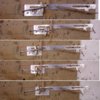This is a compilation of posts “lost” because of the hacker attack
I intended to make a mould for the nose section from Plaster of Paris but a trip to our local chemists drew a blank; they even tried to order some from their supplier with no luck. During a recent decorating episode, which involved a fair amount of repair work to the walls in preparation for emulsion painting, we used Polyfiller, it seemed very similar to Plaster of Paris so thought I’d try it.
The plug was prepared by dripping molten candle wax all over it, heating it up with a hot air gun re-melts the wax and most of it drips off leaving a very thin layer. I mounted it on a plastic base with a wall of Plasticine and then gave the lot a spray with WD40.

The Polyfiller was mixed quite thin and carefully poured in to fill the mould. It’s not as quick setting as Plaster of Paris; it took about 2 hours to harden and be ready to remove the Plasticine and the base, then another couple more to dry before carefully easing out the plug.

It has actually turned out surprisingly well; there are a few places where the Polyfiller has broken away in between the lugs but to be honest I expected a lot worse. It remains to be seen whether or not I can use the mould to produce acceptable rubber nose sections; I still have my doubts.
There was a reply from Alan2525 about the type of rubber
Alan
I have not idea what sort of rubber I’ve used; I bought it years ago from the model shop, I think its intended use was for making moulds for casting Plaster of Paris figurines. It’s very soft with a “natural” colour; you melt it over a low heat then pour it either into a mould or over a plug dependant upon whether you’re making a male or female item, and then just let it cool and set.
Grahame
Being thermo-plastic it was easy to “touch up” the mouldings using a precision screwdriver heated over a candle flame. They’ve been glued to a 1/64th ply base with cyano and given a coat of black paint.

The finished parts are not perfect but I’m not going to too much trouble as they are “throw away” parts and as such will be attached to the bombs with double-sided tape for easy replacement, I’m sure they will need replacing after just a few “bombing runs”. I might make a set of better finished parts for static display.














